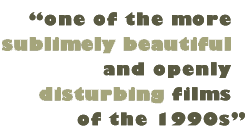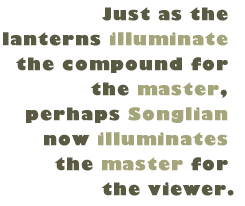Home-Art
329-GS 330-Lit 342-Hum 375-Com
385-GS 410-GS 450, Research-GS
450, Integration
|
|
|
Written by Jessica Albon |
|

|
 aise the Red Lantern (1991), directed by Zhang Yimou, is a visual masterpiece. According to James Berardinelli, in fact, it is "one of the more sublimely beautiful and openly disturbing films of the 1990s." This is a sentiment one finds echoed often in various reviews. So the question becomes, what gives the film this visual power? Perhaps part of this visual power is attributable to Zhangís need to experiment. As he said in an interview, "I'm always interested in trying different styles. I try to do something different with every film" (qtd. in Palmer). While there is a wide variety of elements that add to the complex visual image of this film, in the interest of space, this paper will focus on the power of symmetry and parallelism within the film. Both symmetry and parallelism are visual techniques that are employed to elicit powerful visual responses from the viewer. While symmetry and asymmetry are present in virtually every frame of this film, and one can make many frames similar or dissimilar by examining them in great enough depth, there are six specific shots in Raise the Red Lantern that become more visually compelling through their use of parallelism or symmetry. Visual parallelism serves to unite two characters, events, scenes, or frames together in the consciousness of the viewer. This technique provides the observer with a visual link between the two images. A director might use visual parallels to strengthen a point or to help the viewer understand the relationship between two characters. In Raise the Red Lantern, Zhang uses parallelism to link characters and to link scenes. By framing certain objects or characters in certain ways, he shows the viewer the importance of those characters or objects. Additionally, he links them together so the viewer considers them not only as separate objects, but also in relation to one another. In this way, the director subtly leads his audience to sense the link on an almost subconscious level. |
|
|
Songlian
is often shot directly from the front with her face and shoulders filling the screen.
The other characters are typically not shot so intimately. Rather Zhang shoots other
characters at greater distance or at an angle, indicating the viewer is expected to
relate more to Songlian. This technique encourages the viewer to see other characters as
less significant. In an effort to link Songlian and the masterís son, however, Zhang
uses his camera to show similarity between the two by affording them similar head shots.
This occurs both when Songlian meets the masterís son on the roof, while he is playing
the flute, and then again on Songlianís birthday. In this way Zhang seems to be
telling viewers that these two characters have something important in common. Perhaps,
as some critics have suggested, Zhang was attempting to appeal to American viewers by
hinting at a potential romance between Songlian and the masterís son. Or perhaps he
was showing that Songlianís life would have been significantly different had she been
born into different circumstances. Another possibility is that the director uses the two
of them to juxtapose the extreme difference in their personal freedom based on their
gender roles (see Dalgeshi).
Visual parallels are drawn between different facets of Songlian herself. In the first frames of the movie, her hair is in braids and she is in her "school-girl" clothing. At the end of the film, we see her framed in much the same way in the same clothing, though now her braids are unkempt and there are lanterns surrounding her. Perhaps Zhang intended to show that Songlian is the same person as she was when she arrived at the compound, though the master has labeled her crazy and so that is how we now see her. Because the master has complete visual control, his every whim is associated with visual consequences. In this way, his telling Songlian that she is crazy would result in our seeing her as crazy. She is unable to adapt to the "traditions" of the family and instead she remains the "girl from the university" (see Delamoir). When the fifth wife arrives at the compound, she is shot with a close up similar to those used to frame Songlian. Zhangís choice to shoot her in this way forces the viewer to consider the fifth wifeís future. Will she be as strong as Songlian was? Certainly, she must have something in common with Songlian to be afforded a similar shot. She is shot in bridal apparelóthose in keeping with family tradition and perhaps this will save her from Songlianís fate. The director leaves the audience in a state of uncertainty concerning the fifth wifeís fate. Will she fit in or fade into the night? Symmetry in Raise the Red Lantern seems to indicate the masterís power. He likes everything "just so" and as a result, everything that the viewer sees is arranged meticulously. The symmetrical arrangement of the compound gives the scenes presented within it a staged, sterile appearance. The master may not be able to control what his wives think, but he surely makes every effort to control what they see and do. Because of this, the viewer may feel the precise arrangement of objects has a unique purpose. |
|
The first
scene in which symmetry is readily apparent is the scene in which Songlian is waiting
for the master. She has been attended to by servants and they have dressed her in order
to make sure she is appropriately attired for the master. Then they leave her alone.
Symmetry is a age-old technique used often to convey formality. Aside from adding to the
stiff formality of the room, the symmetry of this shot as she waits for the master also
serves to deepen her isolation. She sits at the center, dwarfed by the room around her,
overwhelmed by the life she has entered. The symmetry of this shot, the idea that
everything is staged perfectly, adds to the viewerís realization that she has wound up
with far more than she bargained for.
Following the scene of her isolation, we see her humiliated when the master demands she hold a lantern to her face. Again the shot is symmetrical with lanterns on either side of her head. Even though he isnít seen, the symmetry serves as a strong reminder of the masterís presence. Enforcing his role as controller of what is seen, his voice is heard directing Songlian in how she holds the lantern and how she stands. It is almost as if he is choreographing a scene, not getting ready for their first encounter as a married couple (see Delamoir). Symmetry serves to deepen the dread during the scene in which the third wife is hanged. As most of the servants arrange things inside the room on the roof, one paces at the center of the screen outside the room. The right side of the screen is made heavy by the buildingís presence, its outline concrete against the pale gray sky. In this scene, symmetry gives way to a calculated asymmetry and the viewerís eye is continually pulled to the building. This heightens the "I donít want to watch, but I canít help it" mentality viewers often encounter in horror and suspense films. However, Raise the Red Lantern is neither a horror film nor a suspense film and instead uses this tactic to force the viewer to participate, though s/he is reluctant. This technique also heightens the viewerís dread and horror over what is happening. |
|
|
At the end
of the film, symmetry is again revisited with Songlian and the lanterns. The red
lanterns are hung evenly on either side of her, with the top of her head aligned with
the top of the lanterns. Perhaps the symmetry of this scene serves to hint to the
viewer that in some small way Songlian has exercised her will. Before this scene, we see
her lighting her lanterns, the black bags that had covered them strewn in the snow.
Perhaps she has chosen now to surround herself with lighted lanterns and to make herself
their equal. Just as the lanterns illuminate the compound for the master, perhaps
Songlian now illuminates the master for the viewer.
See Works Cited |


